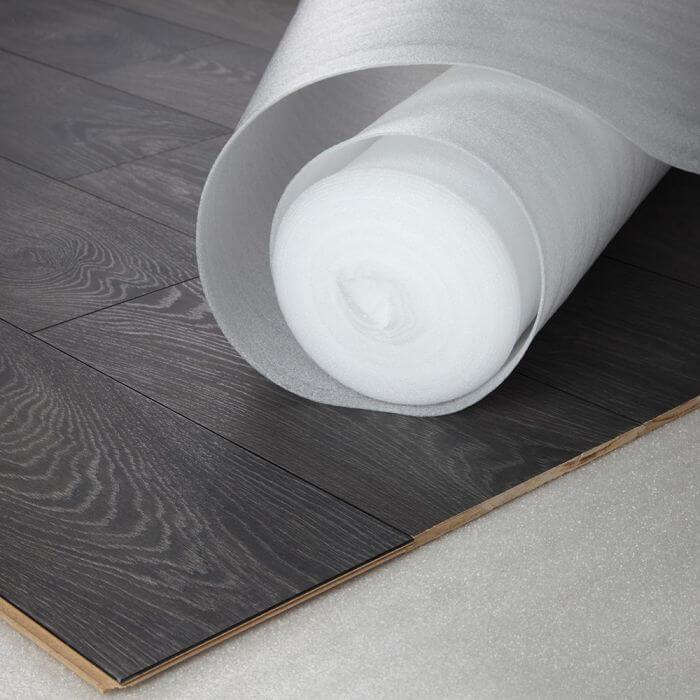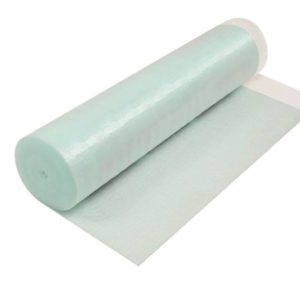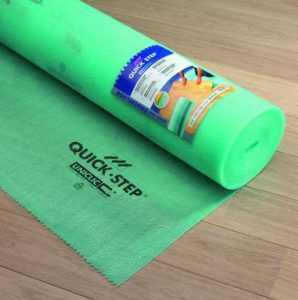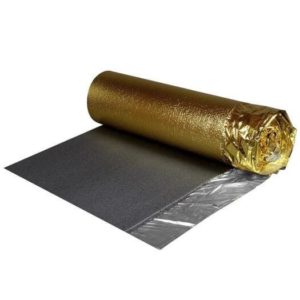If you’ve just purchased new laminate flooring, it’s time to get a good underlay. No matter how good the laminate flooring you choose is, if the underlayment is not right, then the benefits of your laminate flooring could go to waste. Read our advice on choosing the best underlay for laminate flooring on concrete or other materials.
What is Underlay?
Underlay or underlayment is a thin, flexible and resilient sheet that is spread on the top of the surface underneath the laminate flooring, most commonly concrete. It acts as a base for the laminate flooring and is responsible for evening the surface so that your laminate is spread well.
Every subfloor will have minor imperfections and underlay helps to prevent these from affecting the final finish of your floor so your new laminate can float without problems. It also allows your laminate floor to expand and contract (a natural process in reaction to heat) without scratches or abrasion from the subfloor.
Benefits of Underlay
The underlay acts as a foundation of the floor and is installed to enhance the life of the laminate flooring. The underlayment must perform several functions, such as to:
- Level the uneven surface
- Reduce sound transmission
- Improve the R-value of the floor
- Act as a cushion to the laminate plank
- Provide additional heat insulation
A high quality underlay can bring a huge number of benefits to your flooring, protecting it and increasing its lifespan, as well as improving the insulation of your home.
How To Choose the Best Underlay
Generally, most types of underlay are suitable for laminate flooring as it’s fitted through the floating floor installation method without the need for nails or screws.
However, you still need to think while buying the underlayment for your laminate flooring. If you end up buying the wrong type, both the look and feel of your laminate flooring can be distorted. There are many things to consider when purchasing underlayment:
- The climate of the region
- Your personal needs for the space
- The type of subfloor on which the underlayment is to be installed
Usually, it’s the type of subfloor that has the biggest impact upon which underlay you should choose.
People often want to go for a soft underlayment or make use of carpet padding, but it’s to be understood that the soft underlayment will not increase the comfort of walking on the floor as the laminate will feel the same. Read the best types of underlay for different subfloors.
Best Underlayment For Laminate on Concrete
Damp Proof Underlay
Concrete subfloors can result in moisture affecting your new laminate flooring. This will damage the floor and reduce its lifespan. People still commonly use foam underlay in these instances, which is often acceptable, but the very best choice is a moisture or damp resistant underlayment — especially for areas in the home that commonly come into contact with moisture.
This will provide the best protection against damp and moisture that may rise up from the concrete and affect your floor. If you’re fitting laminate flooring into your basement, a damp proof underlay is essential.
This Krono Original underlay is damp proof to protect your new laminate floor.
This is also appropriate for areas that experience a lot of moisture such as bathrooms or kitchens.
Combination
Another good underlayment for concrete subfloors is the combination of foam underlay with a vapour barrier layer that helps to prevent moisture penetration in the laminate flooring.
This combines the insulating benefits of foam with the moisture resistance of damp proof underlay.
Underlay for Wood Subfloors
Foam Underlay
Foam underlayment is the most common and popular form of underlay. It can be used for laminate flooring on concrete subfloors in areas that aren’t prone to moisture, but it best on wood or plywood subfloors. This underlay is a thin sheet made from foam. It acts as a cushion between the surface below and the laminate plank.
One of the best foam underlays is Quick Step’s foam underlay for laminate floors. It’s effective and great value for money. It’s perfect to form a basic underlay when you don’t need anything fancy!
Cork Underlay
The next type of underlayment is a cork underlay. This is mainly used in places where noise reduction is important and is usually one of the more expensive choices, but it is highly effective. It’s a great choice if you have a wood subfloor particularly in an apartment where noise might be a problem.
Underfloor heating
If you have underfloor heating, it’s essential that you choose the right underlay that doesn’t interrupt the effectiveness of your heating system. There are specialist underlays designed for pairing with underfloor heating so ensure you choose one that says it’s suitable. It can’t be too thick, or will insulate heat away from your room!
This underlay from Elka has a vapour resistant layer, provides additional sound insulation and is suitable for underfloor heating systems.
Installing Underlay
After you’ve purchased the underlayment, it’s important to follow the professional’s instructions so that you don’t go wrong when installing it. An improper installation might void the manufacturer’s warranty on the material and mean your floor doesn’t look or perform as well as it could!



